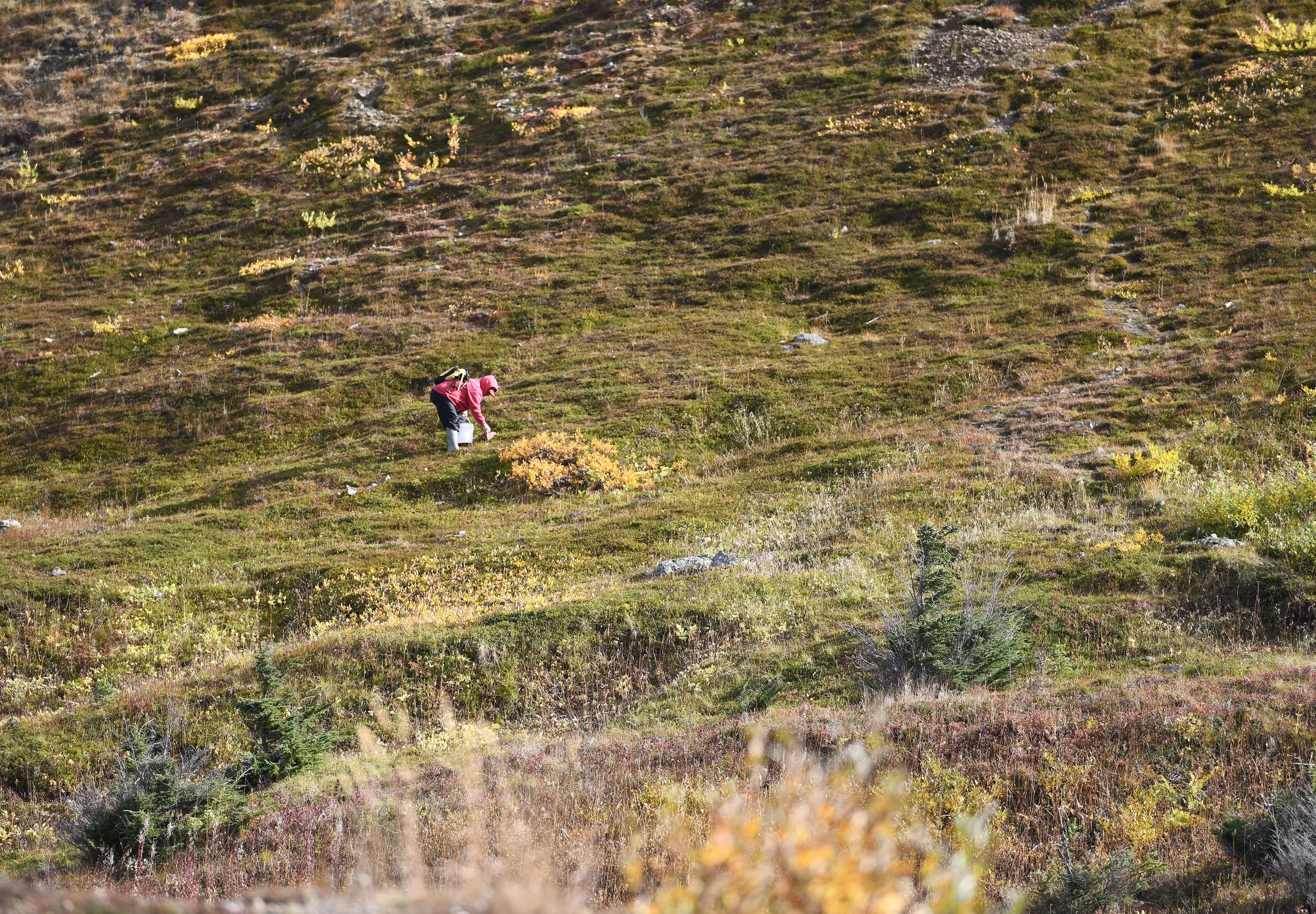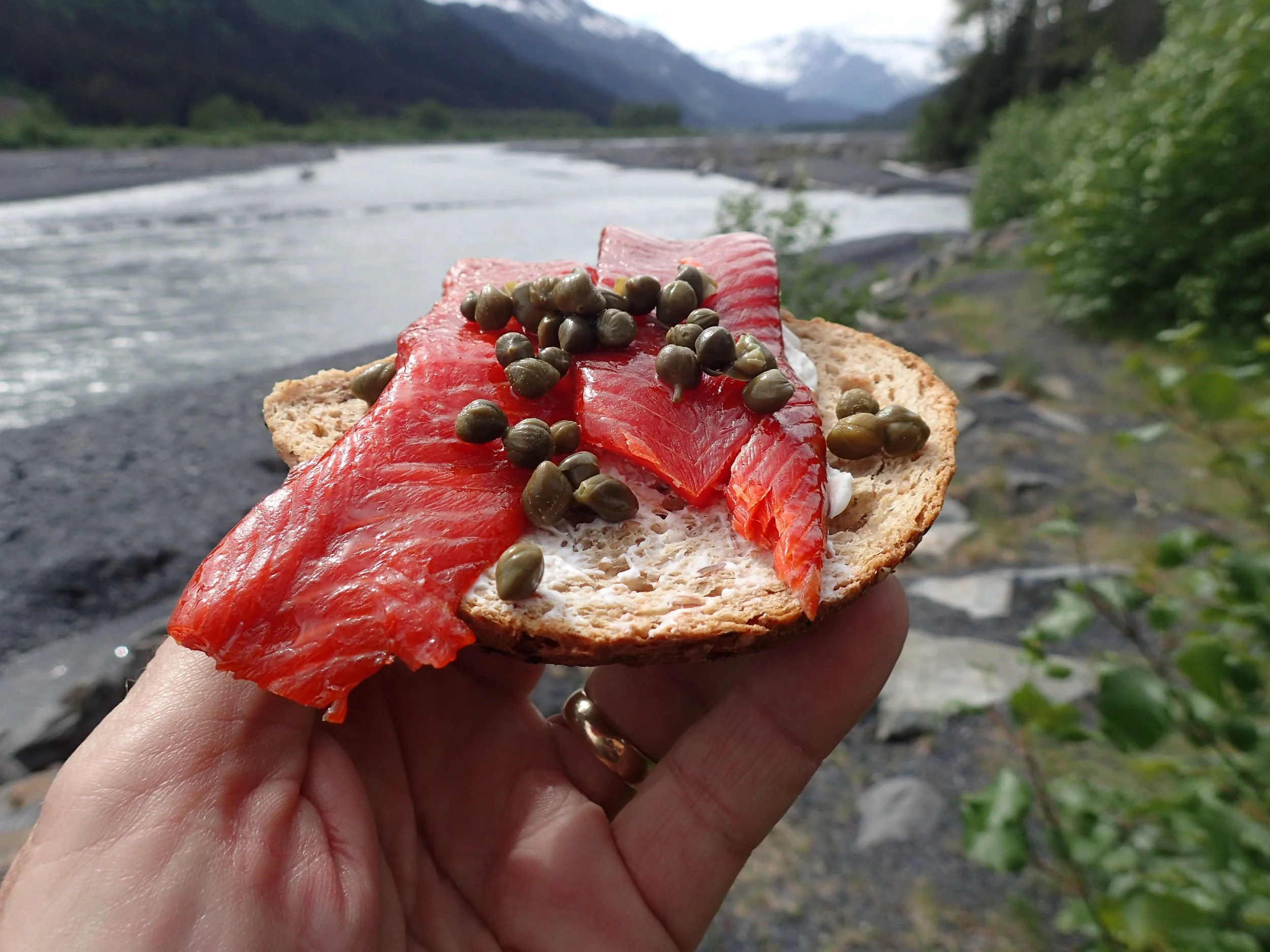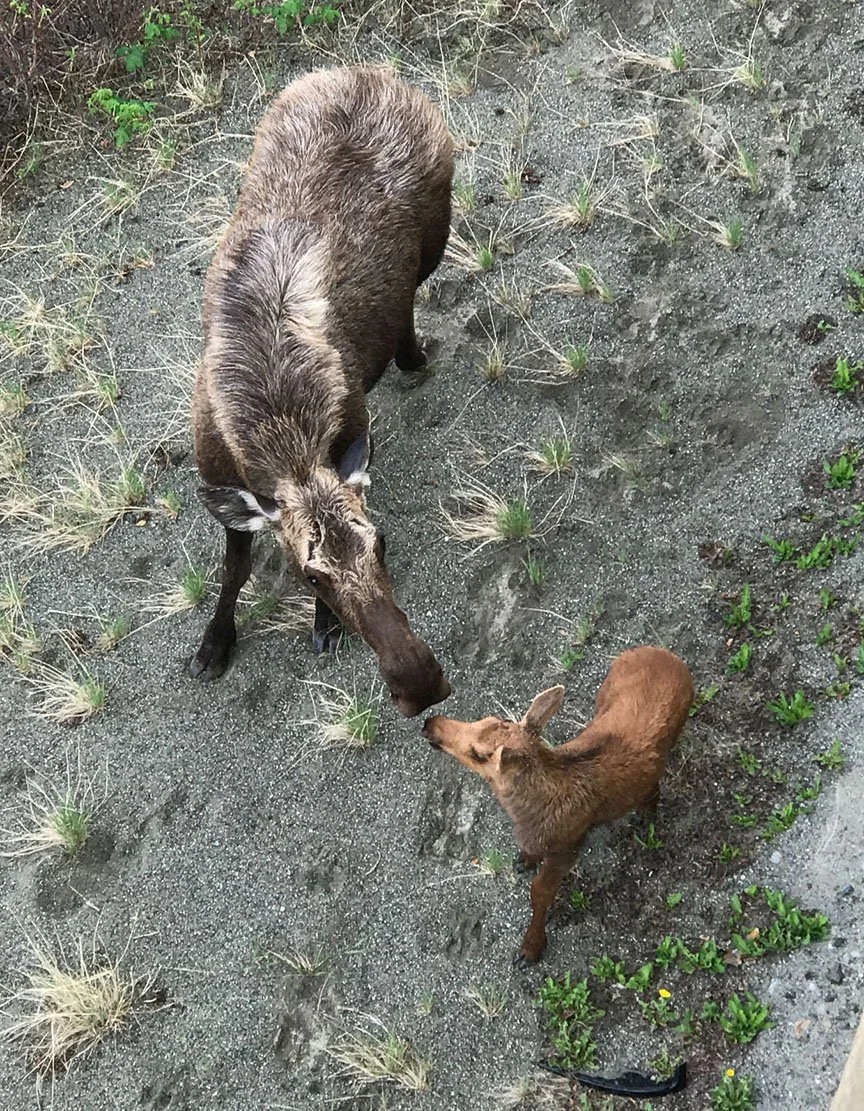Alaska lives up to lofty reputation
Snowcapped Mt. Drum provides a backdrop as Glenn Highway nears Glennallen, Alaska. The 12,011-foot volcano is part of Wrangle St. Elias National Park.
Story and Photos by
By MATTHEW THAYER
Growing up in Kihei, a Hawaii town where temperatures never reach freezing, it was quite a transition for our son, Mark, to be posted in one of America's snowiest cities.
His first duty station in the United States Coast Guard (USCG) was in Valdez, Alaska. The small, remote hamlet at the head of Prince William Sound averages 326.3 inches of snow a year, enough to rank it in the top two snowiest towns in the U.S.
As one of the junior personnel, Mark spent three winters plowing snow from parking lots, streets and driveways for the USCG. A six-hour drive from Anchorage, the harbor town is nicknamed "Little Switzerland" in honor of its tall mountains and scenic beauty. Mark quickly grew to enjoy life in Alaska with all its outdoor activities and challenges, as well as the ability to jump in a vehicle and drive to hunting grounds or fishing holes 400 miles away.
This pullout along Glenn Highway proved to be a perfect place for a picnic lunch during a colorful fall drive from Anchorage to Valdez.
Following his stint in Valdez, Mark was transferred to Anchorage for four years. Serving as a Marine Science Technician, he spent his summers deploying to remote coastal villages all over Alaska's Far North region to help mitigate and prevent negative ecological impacts, such as fuel leaks and chemical spills. His mission continues with his latest posting on his home island of Maui.
As proud parents who always hoped to experience Alaska anyway, my wife Kelly and I were only too happy to fly up to visit our son. Driving, hiking, fishing, woodworking and serving as sherpas on bear, moose and bison hunts over six annual trips, we got to know the Southcentral region fairly well. We also dipped our toes into Alaska’s Interior long enough to shape some general impressions.
Water cascades through Virgin Creek Falls in Girdwood, Alaska. It is a short, easy hike to the falls. Virgin Creek Trail, which continues beyond the falls, is about a half-mile roundtrip through lush rainforest.
If you enjoy nature, it's hard to describe Alaska without sounding like a blurb from the state's travel bureau. Beautiful. Iconic. Wild. Roll the Colorado Rockies, Grand Tetons, Sierra Nevada and Northwest Canada into a ball, sprinkle in 100,000 or so glaciers, 175,000 moose and 140,000 bears and you get something approaching Alaska. America's largest state is not just big—it feels big. Its soaring mountains include the continent's tallest, Denali. Alaska's coastline is longer than the coastlines of all the other states combined. Admitted to the union as the 49th state in 1959, it is two and a half times larger than Texas.
As his years in Alaska added up, Mark's tour guiding skills improved. Visiting a resident means you not only get to take in recommended sights, but there can also be off-the-radar adventures like fishing at secret holes on the Kenai River, rafting down the Copper River in freezing October and four-wheeling long distances on dry riverbeds before the spring melt.
The tour boat Klondike Express passes in front of a Prince William Sound glacier during a cruise out of Whittier, Alaska.
A baby seal reclines on small iceberg floating in Prince William Sound.
Moose, bald eagle and bear are common sights in late spring and early summer, even in the cities. With the valleys cloaked in lush green and the mountains still shrouded in deep snow, that's where the food is. Fall trips brought changing leaves, northern lights, dropping temperatures and a memorable blizzard.
Perhaps the most common mammals spotted in Alaska from late spring to early fall are tourists. According to the Alaska Travel Industry Association, the state had 2.7 million visitors between May 2022 and April 2023. The visitors spent an average of 8.5 days in the state and generated $3.9 billion in direct spending. The Alaska Beacon reported that Alaska set a state record for cruise ship passengers in 2023, with 1.65 million passing through the port of Juneau. Of those, the article said, roughly 400,000 made the trip inland to Denali National Park and Preserve, many of them on the eight-hour train from Anchorage.
A bald eagle makes a sharp turn over Valdez, Alaska.
Denali provided one of our few Alaska disappointments. Due to its 20,310 feet of elevation and location, the majestic peak is blanketed by clouds up to 80 percent of the time. Ask anybody at the national park and they'll be quick to tell you how the mountain creates its own weather system.
We know people who caught Denali on crystal clear days. Several flew over its sun-soaked slopes in chartered planes and one even landed high on an expansive snowfield. To a person, they claimed it was an eye-popping experience.
Not so much for us. Thick clouds, rain and a bumpy five-hour bus ride through more of the same has been our experience. We visited the park for a few days and passed within a would-be view of the great mountain three other times. Hopefully, one of these days, we too will experience the mystical peak on a bluebird day.
Sprouting new horns, a young moose walks along a sidewalk at Anchorage's Kinkaid Park. The huge park at the edge of the city features 40 miles of walking trails, bike trails, athletic fields and plenty of wildlife.
If the mountain is clear while you're visiting, my advice is to do whatever it takes to get up in a plane to see Denali from the air. It is worth noting that the mountain is not visible from the national park headquarters or the Denali Depot train station no matter the weather. For that, you need to drive, take a bus or catch a glimpse from a distance, perhaps from Anchorage Airport 240 miles away.
Anchorage is the state's largest city by far. Sandwiched between the tall Chugach Mountains and Cook Inlet of the Pacific Ocean, it is home to nearly 300,000 people. The sprawling city is laid out in a grid pattern over fairly flat terrain and encompasses wooded parks, swamps and lakes.
A hike on a sunny day at the Eagle River Nature Center commands outstanding views. Forty minutes from Anchorage, the Nature Center includes river valley hikes of varying difficulty, ranging from easy to challenging. Another popular hike nearby is the 2.9-mile loop to the summit of Mt. Baldy.
Flanking the city is the huge Joint Base Elmendorf-Richardson where reportedly more than 30,000 service members, their families and retirees live. The military community makes up roughly 10 percent of Anchorage's population.
As expected of a city its size, even one so far north, Anchorage has a wide selection of amenities, including shopping, dining, movie theaters and cultural venues. Most of the restaurants pack a northern feel, but the multicultural city features cuisines like Bavarian, Thai, Japanese sushi and hearty halibut and steak. You can even buy Spam musubi at local gas stations. The outstanding Anchorage Museum located downtown is also well worth a visit. Its thoughtful exhibits offer windows into the host culture's practices, crafts, artwork and history, along with understandings of the diverse environments and surrounding seas.
The lower portion of the three-mile trail leading to the summit of Alaska's Flattop mountain is a relatively easy grade. Located about 30 minutes from downtown Anchorage, Flattop is reportedly the state's most climbed mountain. The going gets steep and tricky at the top. Proper gear and preparation are recommended for those hoping to reach the 3,281-foot summit.
A indigenous Alaskan harvests fall berries on the flanks of Qin cheghi, also known as Flattop Mountain.
Anchorage is a handy base for day-tripping or a good place to stock up on supplies before heading out on road trips or train travel. In mid-summer, the sun shines nearly all day long. Emerging from an Anchorage theater at midnight, I remember being surprised that it was barely dusk. Winter brings long nights, including only 5.5 hours of light on the winter solstice.
If you are planning an Alaska road trip, keep in mind just how big the state is. Unless you have unlimited time, or a penchant for driving 24/7, you can't do it all. Leave time on the itinerary to pull over and savor the views, to linger over picnics and maybe turn down a public road less traveled. As with most things in life, roaming Alaska is as much about the journey as the destination itself.
A spawning salmon leaps to clear a waterfall near Seward.
One of our favorite Alaska towns to visit is Homer. Located near the end of Sterling Highway, a nearly five-hour drive from Anchorage, the lively harbor town with postcard views reminds us a bit of Lahaina back in the day. Homer moves to its own vibe and rhythm. Kelly enjoys perusing the stores on "The Spit," while I hunt for photo opportunities amid the boats, beaches and blooming wildflowers. A highlight was eating raw oysters and fresh salmon while overlooking the sea at Captain Pattie's Fish House.
Homer's Spit juts 4.5 miles into Kachemak Bay. The narrow finger of land features activities and amenities that include: boating, restaurants, shops, hotels, beachcombing and fishing.
Lupines, or bluebonnets, bloom in early summer along the Homer Spit.
The drive to Homer from Anchorage is one postcard moment after another. We spotted at least 20 moose on one journey, with the sightings growing especially thick as we neared Homer. Motoring between the sea and snowcapped mountains, through forests and along lakes and rivers, the jaw-dropping views were punctuated on another journey by the bleak reality of a smoldering wildfire that had blackened many thousands of acres of woodlands. The road had only recently opened, and we were some of the first tourists to drive through.
Smoked salmon belly, capers and cream cheese top a slice of bread during a picnic below Exit Glacier, near Seward.
Seward is another harbor town at the terminus of a scenic highway. About a 2.5-hour drive from Anchorage and four hours by Alaska Railroad train car, Seward boasts the Alaska SeaLife Center aquarium, great hiking and access to the foot of glaciers. Restaurants were packed to the rafters when we visited, but we put our name on the list at Ray's Waterfront, explored the harbor for a while and then found places at the friendly restaurant's bar until it was our turn for a table. The wait became a time of fun conversation and sharing notes with fellow travelers.
A band of clouds dissipates over Turnagain Arm near Girdwood.
On the drive to both Seward and Homer, while rounding the coastline of picturesque Turnagain Arm, you pass near the town of Girdwood and the nearby Alaska Wildlife Conservation Center. Both are easy day trips from Anchorage. In Girdwood, we took the tram fronting the luxury Alyeska Resort hotel up to a scenic lookout for lunch. The area has pretty hikes, skiing in winter and a famous townie Cajun restaurant known for its huge portions, the Double Musky Inn. On another visit to Alyeska Resort's impressive grounds, we watched a mother black bear forage as her two cubs practiced climbing a tree.
A few hours at the Alaska Wildlife Conservation Center provides a chance to safely get up close to animals, including brown bears, wolves, elk, caribou and moose. For amateur wildlife photographers, this is a slam dunk.
The bear skin nailed to the ceiling over the Fairview Inn's bar is just part of the eclectic ambience of Talkeetna's no-frills watering hole.
Far inland from those towns, tiny Talkeetna seems like more of a place to briefly pause to refuel than a destination. That didn't keep us from booking rooms twice at the comfortable Denali Overlook Inn. With its huge windows and wide vistas, the inn is known for its stunning views of Denali. I cannot personally confirm that fact, though I did see pictures. A fun Talkeetna memory is quaffing a local draft brew and listening to a hot country band in the venerable Fairview Inn. Jimmie Rodgers and Merle Haggard were blaring from the speakers. A bear skin was nailed to the ceiling.
The road from Anchorage to Valdez winds through very pretty country as it skirts the Chugach Range. The lonely journey passes mirrored lakes and giant glaciers and winds down through scenic Thompson Pass. The last time we stayed in Valdez, its new cruise ship terminal was under construction. Now that the dock is open for summer seasons, I wonder what changes the cruise industry has brought to the sleepy town across the fjord from the terminus of the Alaska Pipeline. The squared-away little municipality with one grocery store, a bustling post office and very well-stocked Ace Hardware felt like a throwback to the 1950s.
A fisherman lets out net in Prince William Sound.
Nuts and Bolts
If roughing it is your idea of fun and if you don't mind covering long scenic distances to get from place to place, Alaska is well worth visiting. At least, it is for those who can afford it. Alaska is by no means a bargain destination. We found prices for food, goods and entertainment about on par with, or more than, what we pay in Hawaii. Both states are at the end of supply lines. In Alaska, the farther afield you go, the more you'll pay for everything from hamburgers to gasoline.
The author and wife, Kelly Thayer, pose with their son, Mark Thayer, after a day of salmon fishing at a semi-secret spot on Alaska's Kenai River. (Photo by a fellow fisherman)
If you plan to visit during Alaska's summer high season, it's recommended to make car, room and activity reservations ahead of time. Put it off, and nothing may be available, or you'll pay dearly for what is left. Off season is a different story. If you're traveling then, you may want to confirm what is open. A lot of stores, restaurants, lodgings and activities close once tourism winds down. Towns like Valdez roll up pretty tight for winter.
The Northern Lights glow over the horizon during a fall rafting trip down Alaska's Copper River. A crackling fire provides relief from temperatures that dipped to 12 degrees that night–considered balmy compared to when it really gets cold in the 49th state. The Big Dipper constellation, featured prominently in the state's flag, is visible top left.
Summer weather in Alaska is variable and unpredictable. Winter is determined to kill you. Whatever the season, mistakes can be fatal. As can encounters with bear and moose. When in doubt, ask a local for advice. They may share a bit of wisdom that our son, Mark, adopted as he acclimated to the harsh winters: "There's no bad weather, just bad gear."
I would say it pays to have a solid lay of the land before putting that adage to the test. Alaska is a big state full of challenges that match its outsized beauty.
An Alaskan moose shares a tender moment with her baby. (Kelly Thayer photo)
A bald eagle soars over Valdez, Alaska.
Colorful foliage lines a lower section of trail at Flattop Mountain.





















